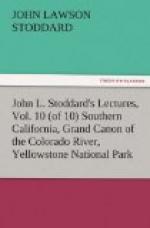is the irrigating ditch; its “open sesame”
is water; and the divinity who, at the call of man,
bestows the priceless gift, is the Madre of the Sierras.
A Roman conqueror once said that he had but to stamp
upon the earth and legions would spring up to do his
bidding. So Capital has stamped upon this sandy
wilderness, and in a single generation a civilized
community has leaped into astonished life. Yet
do we realize the immense amount of labor necessitated
by such irrigation? This mountain, for example,
is covered with water pipes, as electric wires are
carried through our houses. Every few rods a pipe
with a faucet rises from the ground; and as there
are miles of roads and hundreds of cultivated acres,
it can with difficulty be imagined how many of these
pipes have been laid, and how innumerable are the little
ditches, through which the water is made to flow.
Should man relax his diligence for a single year,
the region would relapse into sterility; but, on the
other hand, what a land is this for those who have
the skill and industry to call forth all its capabilities!
What powers of productiveness may still be sleeping
underneath its soil, awaiting but the kiss of water
and the touch of man to waken them to life! Beside
its hidden rivers what future cities may spring forth
to joyous being; and what new, undiscovered chemistry
may not this mingling of mountain, sun, and ocean
yet evolve to prove a permanent blessing to mankind!
[Illustration: Grounds of the
Smiley brothers on the “Converted
mountain.”]
[Illustration: Irrigating ditches.]
One hundred and twenty-six miles southwest of Los
Angeles, one could imagine that he had reached the
limit of the civilized world: eastward, the desert
stretches far away to the bases of the San Jacinto
Mountains; westward, thousands of miles of ocean billows
shoulder one another toward the setting sun; southward,
extends that barren, almost unknown strip of earth,
the peninsula of Lower California; yet in this cul-de-sac,
this corner between mountain, desert, and sea, rises
a charming and inspiring picture,—San Diego.
[Illustration: San Diego.]
The beautiful harbor of this city is almost closed,
on one side, by a bold majestic promontory called
Point Loma; and on the other, by a natural breakwater,
in the form of a crescent, twelve miles long, upon
the outer rim of which the ocean beats a ceaseless
monody. At one extremity of this silver strand,
directly opposite Point Loma and close to the rhythmic
surf, stands the Hotel Coronado; its west front facing
the Pacific, its east side looking on the azure of
the peaceful bay, beyond which rises San Diego with
a population of twenty thousand souls. To reach
this hotel, the tourist crosses the harbor from the
city by a ferry, and then in an electric car is whirled
for a mile along an avenue which he might well suppose




